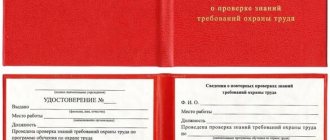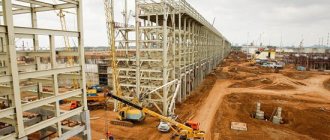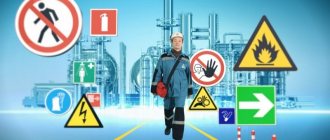The employer must have instructions:
- About first aid.
- On fire safety.
- For each position.
- In the most traumatic areas of activity (when working with electricity, at heights, on vehicles, etc.)
The obligation to develop this document is enshrined in Article 212 of the Labor Code of the Russian Federation. Neglect on the part of the employer is punishable by a fine of up to 200 thousand rubles or imprisonment for up to 5 years. For workers, ignoring occupational safety regulations can be deadly.
Development
The development of safety instructions is carried out on the basis of inter-industry or industry standard instructions. For example, a standard instruction on labor protection for a baker was approved by Resolution of the Ministry of Labor dated May 24, 2002 No. 36 “On approval of inter-industry standard instructions...”
In the absence of regulatory documents approving cross-industry or sectoral requirements for safe working conditions, these regulatory documents are developed on the basis of the safety requirements set out in the operational documentation that comes with the equipment.
The procedure for developing documents is determined by the employer, who can independently deal with this issue, or can entrust it to a specially appointed employee (usually a labor protection engineer, whose job description contains the corresponding responsibility).
https://youtu.be/OKx0aw2CVcg
Education Lawyer
1. Title page The type of title page is given in the Methodological Recommendations approved by the Ministry of Labor of Russia on May 13, 2004.
| AGREED Chairman of the trade union committee ____________ / A.A. Karaseva June 01, 2020 | APPROVED by the school director ____________ / G.V. Teplykh June 01, 2017 |
| INSTRUCTIONS labor protection for teachers IOT – 10 | |
The stamp “AGREED” must be indicated only if the coordination of labor protection instructions with the trade union committee (or other representative body) is provided for in the charter or collective agreement of the institution. Otherwise, you need to make a note: “The opinion of the trade union committee has been taken into account. Motivated opinion from “___” __________ 2020 No. ___.”
On the reverse side of the title page you must indicate the developer of the instructions with his signature.
2. Introduction
Here the details of the regulatory documents are indicated (name of the body that issued the document, date, number, name of the document), on the basis (in pursuance) of which the instructions are developed. Such regulatory documents include: – intersectoral or industry standard instructions (for example, Decree of the Ministry of Labor of the Russian Federation dated May 24, 2002 No. 36 “On approval of intersectoral standard instructions on labor protection for workers in the public catering system”); – intersectoral or sectoral rules on labor protection (for example, order of the Ministry of Labor of Russia dated March 28, 2014 No. 155n “On approval of the Rules on labor protection when working at height”); – rules for the safe operation of equipment (for example, order of the Ministry of Energy of Russia dated January 13, 2003 No. 6 “On approval of the Rules for the technical operation of consumer electrical installations”); – state standards (for example, “GOST 12.0.004-2015. Interstate standard. System of occupational safety standards. Organization of occupational safety training. General provisions” (put into effect by order of Rosstandart dated 06/09/2016 No. 600-st)).
3. General requirements for labor protection
This section specifies: – regulatory documents, the requirements of which must be observed and fulfilled by the employee; – list of dangerous and harmful factors; – the procedure for employee reporting information about injuries, malfunctions and breakdowns of equipment, tools, damage to personal protective equipment; – frequency of medical examinations and occupational safety briefings; – rules of first aid; – liability for non-compliance (improper execution) of labor protection instructions.
4. Labor protection requirements before starting work
In this section it is necessary to indicate information: – on the preparation of the workplace and personal protective equipment; – on checking the serviceability of equipment, tools, technical training aids, etc., – on actions in case of detection of malfunctions and circumstances that worsen working conditions in the workplace.
5. Labor protection requirements during work
Approximate contents of this section: – rules for safe operation of equipment; – rules for the use of personal protective equipment; – requirements, compliance and implementation of which minimizes the likelihood of accidents (emergency situations) and accidents; – list of prohibited actions; – rules for the use of personal protective equipment.
6. Occupational safety requirements in emergency situations
This describes possible accidents (emergency situations), their causes and the employee’s actions when they occur, including the procedure for providing first aid in case of accidents.
7. Labor protection requirements upon completion of work
This section records the algorithm of actions for correct shutdown of work: – the procedure for shutting down and stopping equipment, equipment, technical training aids, devices; – the procedure for cleaning machines, machines, equipment, and workplaces; – waste management procedure; – the procedure for implementing personal hygiene requirements; – the procedure for notifying the immediate supervisor about circumstances that affect labor safety.
Other related articles
- What is the difference between a donation and a charitable donation?
- Fines for violations in the field of labor protection
Professional standard Specialist in the field of labor protection
When developing regulations governing the safe work of employees, it is advisable to be guided by the provisions of the Methodological Recommendations approved by the Ministry of Labor on May 13, 2004.
Documents on safe working conditions are developed for 5 years. After this time they are subject to revision.
They must be processed ahead of schedule in the following cases:
- renegotiation of cross-industry or sectoral agreements;
- changes in employee working conditions;
- introduction of new equipment and technologies;
- occurrence of accidents;
- regulations of regulatory authorities.
If none of the above has happened within 5 years, the validity of the instruction is extended for the next 5 years.
In the section “Occupational safety requirements during work” it is recommended to provide:
- methods and techniques for performing work safely, rules for using technological equipment, devices and tools;
- requirements for safe handling of starting materials (raw materials, blanks, semi-finished products);
- rules for the safe operation of vehicles, containers and lifting mechanisms;
- instructions for maintaining a safe workplace;
- main types of deviations from the standard technological regime and methods for their elimination;
- actions aimed at preventing emergency situations;
- requirements for the use of protective equipment for workers.
Preparation of work safety documents
The regulatory act on occupational safety must contain sections with safety requirements:
- general section;
- before starting work;
- during work;
- in emergency situations;
- upon completion of work.
If necessary, additional sections can be included.
It is recommended to format the first sheet as follows:
For new capacities being commissioned, it is allowed to develop and apply temporary regulations for employees who must ensure the safe conduct of production processes and the safe operation of equipment.
Instruction sections
The labor protection instructions must include the following sections:
1. General labor protection requirements . As a rule, this section includes:
- Requirements for the age and health of workers;
- Work and rest schedules;
- List and standards for issuing special clothing, safety shoes and personal protective equipment;
- List of dangerous and harmful factors.
2. Labor protection requirements before starting work . The following items can be included in this section:
- The procedure for preparing the workplace;
- The procedure for inspecting tools and personal protective equipment;
- The procedure for checking the serviceability of equipment, fences, alarms, protective grounding, ventilation, local lighting, etc.;
- The procedure for accepting and handing over shifts.
3. Labor protection requirements during work . In this section it is recommended to indicate:
- Techniques and methods for safe work performance;
- Instructions on maintaining the workplace during the working day.
4. Occupational safety requirements in emergency situations . Here you should indicate:
- List of possible emergency situations and the reasons for their occurrence;
- Procedure for an employee to act in case of fire or accident;
- The procedure for notifying senior management, fire and medical services;
- The procedure for providing first aid to victims.
5. Labor protection requirements upon completion of work . Here you can specify:
- Equipment shutdown procedure;
- Procedure for cleaning the workplace and waste;
- The procedure for notifying responsible persons about detected deficiencies;
- Personal hygiene requirements.
If necessary, additional sections may be included in the instructions.
Note: For workers at hazardous production facilities, safety rules provide for the development of production instructions. It is advisable to combine such instructions with labor protection instructions. For example, “Occupational safety and production instructions for tower crane operators.”
List of labor safety instructions
All developed and approved regulations governing work safety are subject to recording and issuance.
The first journal (accounting) is kept in accordance with Appendix No. 2 to the Methodological Recommendation dated May 13, 2004, its form is as follows:
| № | date | Name of instructions | Approval date | Designation or number | Planned inspection period | Full name and position of the employee performing accounting | Employee signature |
| 1 | 2 | 3 | 4 | 5 | 6 | 7 | 8 |
Legal regulation
Local documents in the field of labor protection, which are developed and approved at the enterprise, are based on the requirements of legal acts that establish standards for safe working conditions and rules for ensuring compliance with them. All these standards together constitute the legislative framework for labor protection, containing laws, regulations and other regulatory documents.
State requirements are mandatory for all entities carrying out any type of activity. This applies not only to the organization of labor and production, but also to carrying out design work, designing equipment, etc. Such regulations can be divided into several types:
- state regulations and sanitary-epidemiological rules;
- occupational safety standards;
- standard instructions in the field of labor protection.
The enterprise develops and approves local acts, which include:
- collective and individual agreements;
- labor protection instructions;
- orders, regulations, etc.
For each employee or group of positions, instructions must be drawn up corresponding to the types of work performed or professions and positions. The basis for this is the Labor Code of the Russian Federation, Article 212, industry or inter-industry standard instructions, safety requirements when performing specific types of work.
Legal requirements are mandatory for all employers and, in the absence of documents on occupational safety, entail a fine. Particularly severe consequences are possible in cases of work-related injuries or accidents when the appropriate instructions are not discovered during the proceedings.
Logbook form
Employees must be familiarized with the requirements of documents regulating work safety upon signature. This does not mean that every employee needs to study all the regulations in this area. This means that the employee must be familiar with those provisions of regulatory documents that relate directly to his professional activities. However, there are documents with which all employees must be familiar - these are regulations on first aid and fire safety.
Employees' familiarization with documents on work safety must be recorded; for this purpose, a second log form is provided (Appendix No. 3 to the Methodological Recommendations dated May 13, 2004)
| № | date of issue | Instruction number | Name | Number of copies issued | Full name, profession, position of the recipient | Signature |
| 1 | 2 | 3 | 4 | 5 | 6 | 7 |
The procedure for agreeing and approving instructions
Who approves the instructions?
All instructions created must be negotiated with the trade union (or other authorized representative) if one is established. In the absence of such a department or representative, the document goes to the department of the heads of these departments. Representatives of the labor service participate in the process, and the final version is approved by the director of the organization.
In addition to the labor protection specialist, the act, if necessary, is coordinated with other parties (technologist, etc.).
When an act is approved, based on the conclusion of the representative body of employees, in the upper left corner, on the main sheet, the stated opinion is not taken into account (usually in the rules, the full scope of which should be kept by the occupational safety engineer and the person to whom the responsibilities of the engineer were assigned by the decrees of the manager , there is a separate document containing the conclusion of the representative body).
If the act was agreed upon with the representative body of this company, such approval is taken into account in the left corner of its front sheet.
The final version is signed by the head of the company (for example, employer - individual entrepreneur, etc.) or his deputy responsible for labor protection (based on the order).
Each approved instruction is assigned a separate name and designation (there may be numbers or letters that determine membership in a specific organizational structure).
Alteration
Changes of any nature that affect labor protection documents must be approved by order of the head of the organization. Its publication is required each time new instructions are introduced, changes are made, re-approved or canceled.
The following cases require changes:
- in connection with the introduction of new regulations, laws, orders, inter-industry and industry standards;
- as prescribed by inspection authorities or a higher organization;
- in case of introduction of new methods of work, technological process or equipment;
- based on the results of an investigation carried out in connection with an industrial accident;
- when the working conditions of workers change.








